
How to Clean White Leather? The Ultimate Guide to Pristine Elegance
Reading Time: about
White leather exudes elegance, sophistication, and a timeless charm. But with its pristine appearance comes the inevitable challenge: keeping it clean.
From the chic white leather sofa that graces your living room to the stylish white leather sneakers you flaunt, each piece tells a story. And like any good story, it deserves to be preserved.
Dive into our comprehensive guide on maintaining the allure of your white leather, ensuring it remains as captivating as the day you first laid eyes on it.
I. Understanding White Leather
White leather, in all its elegance and sophistication, isn't just a singular entity. It comes in various types, each with its unique properties, textures, and care requirements. As we delve deeper into the world of white leather, it's essential to understand these distinctions. After all, the key to effective care and maintenance lies in knowing what you're dealing with.
1. Types of White Leather
a. Aniline Leather
Aniline leather is often considered the crème de la crème of leathers, and for a good reason. This type of leather is dyed exclusively with soluble dyes without covering the surface with any topcoat paint or insoluble pigments. The result? A natural-looking leather that showcases the hide's unique surface. However, this also means that aniline leather is more susceptible to stains and fading. If you've ever come across a piece of white leather that feels incredibly soft and luxurious, chances are it's aniline.
b. Semi-Aniline Leather
As the name suggests, semi-aniline leather strikes a balance. It's dyed with soluble dyes like aniline leather but also has a thin protective topcoat. This makes it more durable and stain-resistant than its aniline counterpart, while still retaining much of the natural appearance. It's a popular choice for those who want the best of both worlds: the natural beauty of aniline and the durability of pigmented leather.
c. Pigmented Leather
If durability is your top priority, pigmented leather might be your best bet. This type of leather is coated with a polymer surface coating, often pigmented, making it resistant to wear and tear, as well as stains. However, this added durability comes at a cost. Pigmented leather doesn't have the same natural feel or look as aniline or semi-aniline leather. But for items that see a lot of use, like sofas or car seats, it's often the go-to choice.
d. Nubuck and Suede
Both nubuck and suede have a soft, velvety surface, but there's a key difference between the two. While suede is made from the inner layer of the hide, nubuck is crafted from the outer layer, making it more durable. However, this soft, brushed surface also means both types are more vulnerable to soiling and staining. If you've ever spilled something on a suede or nubuck shoe, you'll know the struggle.
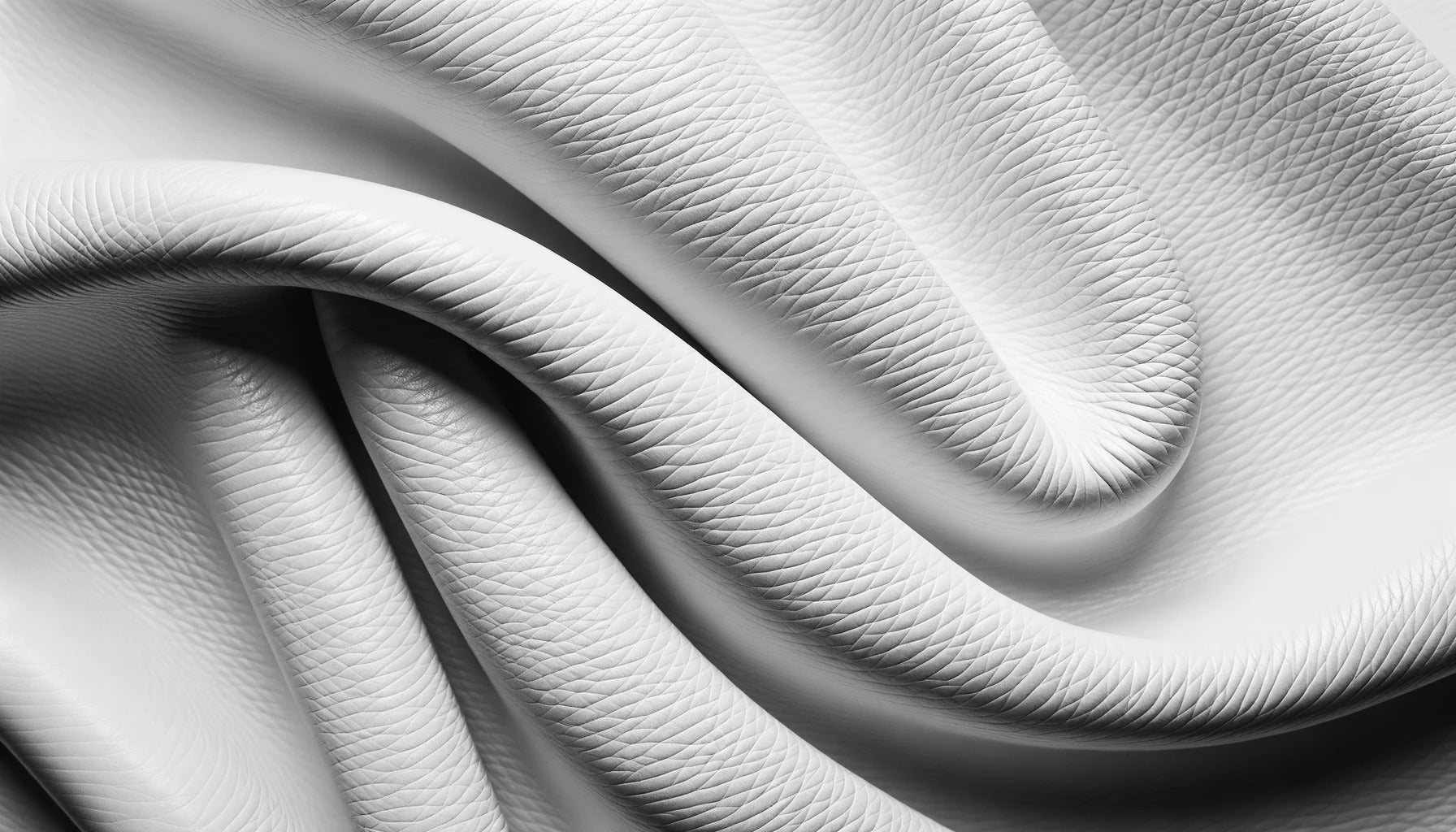
2. Why White Leather Gets Dirty Easily
a. The Nature of White Color
White, by its very nature, is a reflector. It doesn't absorb light but instead bounces it back, making everything on its surface highly visible. This means every tiny speck of dirt, every minor stain, stands out starkly against the white backdrop. It's both the beauty and the bane of white leather. While other colors might hide minor imperfections, white leather is unforgiving in its honesty.
b. External Factors Contributing to Dirt and Stains
Several external factors play a role in making white leather particularly prone to getting dirty. For one, pollutants and contaminants in the air can settle on the leather's surface, leading to gradual discoloration. Then there's the issue of direct contact. Everything from the oils on our skin to the dye in our clothes can transfer onto white leather, leading to stains. And of course, there's the ever-present risk of accidental spills and splashes.
In the world of white leather, knowledge truly is power. By understanding the type of leather you have and the challenges it presents, you're already one step ahead in the game of maintenance and care. As we move forward, we'll arm you with the tools and techniques to tackle these challenges head-on. So, let's continue on this enlightening journey together.
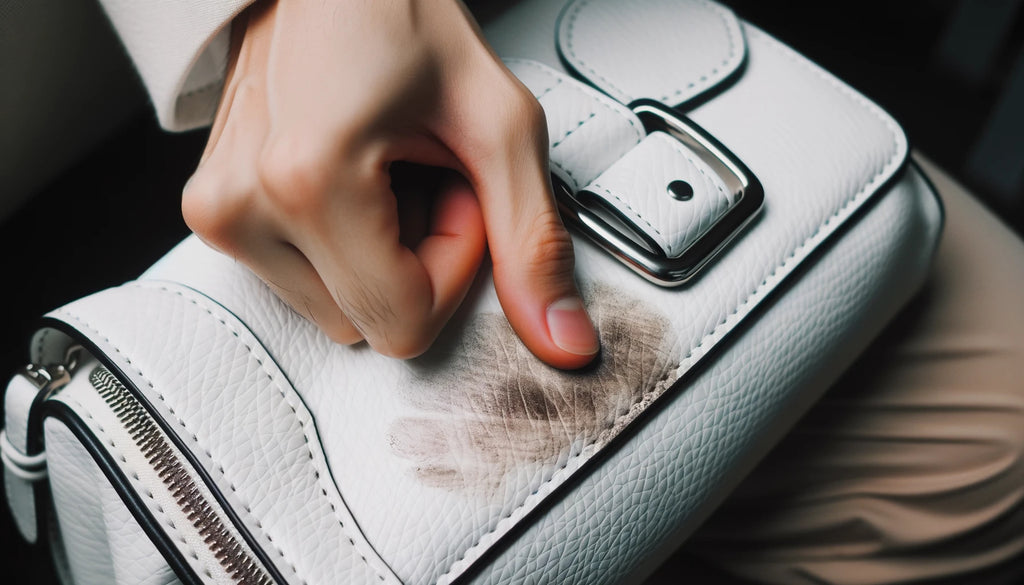
II. Preparation Before Cleaning
Before diving into the cleaning process, it's essential to set the stage. Just like you wouldn't paint a wall without first prepping it, you shouldn't clean leather without some preliminary steps. Proper preparation ensures that the cleaning process is effective and doesn't cause further damage. Let's delve into these preparatory steps.
1. Inspecting the Leather
a. Checking for Pre-existing Damages
The first time I decided to clean a white leather jacket, I made the rookie mistake of not inspecting it thoroughly. Midway through the cleaning, I realized I was exacerbating a small tear. Lesson learned. Before you start with any cleaning, it's crucial to give your leather item a thorough once-over.
Look for any scratches, tears, or weak spots. These areas will need gentle handling. If the damage seems beyond a simple clean, it might be time to consult a professional or consider repairs. Remember, the goal is to rejuvenate your leather item, not worsen its condition.
b. Identifying the Type of Stain
Not all stains are created equal. The method you'd use to tackle an ink stain might be different from what you'd use for a wine spill. Take a moment to identify the stains on your leather. Are they oil-based? Maybe from food or cosmetics? Or are they water-based, like beverage spills?
Once, after a particularly eventful dinner party, I found a mix of stains on my white leather dining chairs - from red wine to curry. Each stain required a different approach. Identifying them beforehand made the cleaning process smoother and more effective.

2. Gathering Necessary Supplies
a. List of Common Cleaning Agents
Depending on the stains and the type of leather, you'll need specific cleaning agents. Here's a basic list to start with:
- Mild soap or leather cleaner: Ideal for general cleaning and light stains.
- Rubbing alcohol or isopropyl alcohol: Effective for ink stains.
- A mixture of lemon juice and cream of tartar: Works wonders on tougher, darker stains.
- White vinegar: A gentle cleaning agent suitable for light stains and general cleaning.
Remember, always do a patch test with any cleaning agent. What works for one leather item might not work for another.
b. Tools and Brushes Suitable for Leather Cleaning
The right tools can make a world of difference. Here's what you'll need:
- Soft microfiber cloths: For wiping and buffing.
- Soft-bristled brushes: To gently scrub away dirt and grime. A toothbrush can work wonders for those hard-to-reach spots.
- Spray bottle: Useful for applying homemade cleaning solutions evenly.
In the next sections, we'll dive into the actual cleaning process, armed with our preparations. Whether you're dealing with a minor stain or looking to refresh an old leather piece, the key is patience and care. With the right techniques, that white leather can shine bright once again.
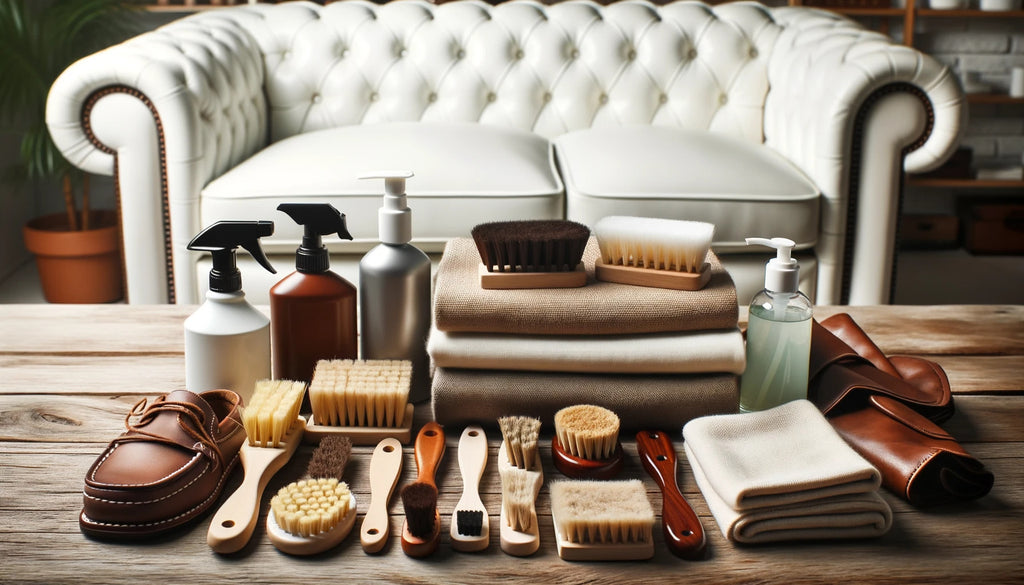
III. Step-by-Step Cleaning Process
Navigating the world of white leather cleaning can be a bit like walking through a minefield. One wrong step, and you could end up with a disaster on your hands. But fear not! With the right guidance and a systematic approach, cleaning white leather can be a breeze. Let's dive into the step-by-step process that I've honed over the years, ensuring that my white leather possessions always remain in tip-top shape.
1. General Cleaning
Before we tackle those pesky stains, it's essential to give your white leather a good general cleaning. Think of this as laying the groundwork for the more intensive cleaning that might follow.
a. Dusting and Vacuuming
You'd be surprised at how much dust and dirt your leather items can accumulate, especially if they've been sitting around for a while. Start by giving them a gentle dusting using a soft brush. For larger items like sofas or chairs, I prefer using a vacuum cleaner with a brush attachment. It's crucial to be gentle during this process; remember, we're trying to clean the leather, not damage it further.
b. Wiping with a Damp Cloth
Once you've removed the surface dust and dirt, it's time to give your leather a gentle wipe-down. I've found that a damp cloth works wonders. Ensure the cloth isn't too wet; you don't want to soak the leather. A quick wipe should be enough to remove any remaining surface dirt.

2. Removing Common Stains
Ah, stains! The bane of white leather owners everywhere. But with the right techniques, even the most stubborn stain doesn't stand a chance.
a. Ink Stains
We've all been there. A pen leak in the bag, an accidental scribble, and suddenly your pristine white leather has a glaring blue or black mark. But don't panic!
-
Using Rubbing Alcohol: Dab a bit of rubbing alcohol onto a cotton ball and gently blot the stain. It's essential not to rub, as this can spread the ink further.
-
Commercial Ink Removers: If the stain proves particularly stubborn, there are commercial ink removers available that are designed specifically for leather. Always do a patch test first to ensure it doesn't discolor the leather.
b. Food and Drink Stains
Whether it's a drop of red wine or a splash of spaghetti sauce, food and drink stains can be a nightmare.
-
Using a Mixture of Mild Soap and Water: Create a mild solution with soap and lukewarm water. Gently dab the stain with a cloth soaked in this solution. Again, remember to blot, not rub.
-
Tackling Stubborn Stains with Baking Soda: For those particularly stubborn stains, a paste of baking soda and water can work wonders. Apply the paste to the stain, let it sit for a few minutes, and then gently wipe it off.
c. Oil and Grease Stains
These can be particularly tricky, as they can seep into the leather, making them challenging to remove.
-
Using Cornstarch or Talcum Powder: Sprinkle a generous amount of cornstarch or talcum powder over the stain and let it sit for a few hours. The powder will absorb the oil, making it easier to brush off.
-
Commercial Grease Removers: For particularly stubborn grease stains, you might need to bring in the big guns. Commercial grease removers can be effective, but as always, do a patch test first.
In the world of white leather, stains are inevitable. But with patience, the right techniques, and a bit of elbow grease, they're also entirely treatable. Remember, the key is to act fast and to always test any cleaning product on an inconspicuous area first. With these tips in your arsenal, you'll be well on your way to keeping your white leather items looking as good as new.
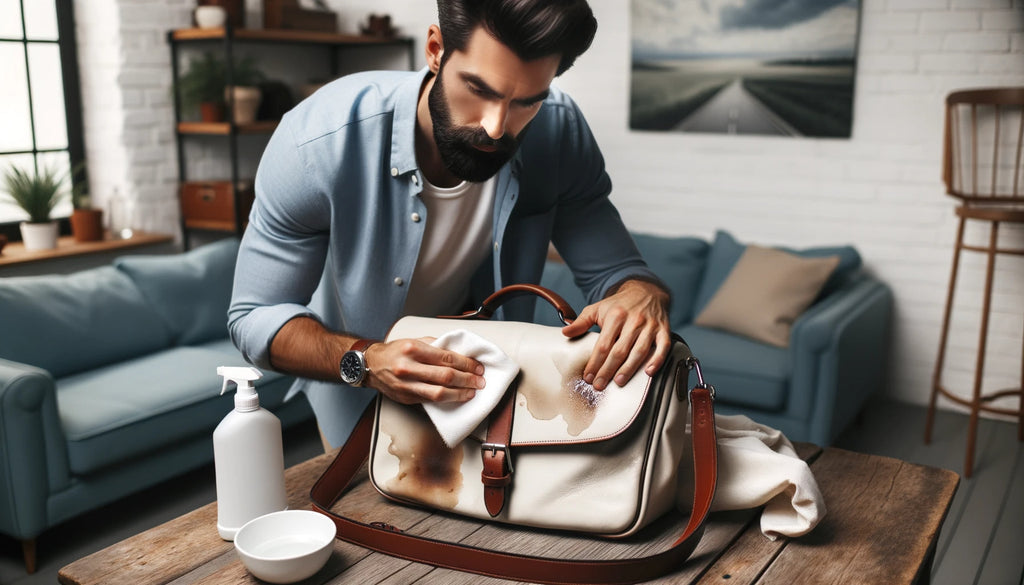
IV. Advanced Cleaning Techniques
In the world of white leather care, sometimes the usual cleaning methods just don't cut it. Especially when dealing with stubborn stains or when you're looking to give your leather items a deep clean. That's where advanced cleaning techniques come into play. Now, I've ventured down this path many times, and I've picked up a thing or two about how to approach these methods with caution and expertise. Let's dive in.
1. Steam Cleaning
Ah, steam cleaning. It's like giving your white leather a spa day. But as relaxing as it sounds, steam cleaning leather requires a delicate touch.
a. Benefits of Steam Cleaning
- Deep Cleaning: Steam penetrates deep into the pores of the leather, helping to lift and remove dirt and grime that regular cleaning might miss.
- Sanitization: The high temperature of the steam not only cleans but also sanitizes the leather, killing bacteria and germs.
- No Harsh Chemicals: Steam cleaning doesn't require any chemicals, making it an eco-friendly and leather-friendly cleaning method.
b. How to Steam Clean Without Damaging the Leather
Now, while steam cleaning has its perks, it's essential to approach it with caution. Here's how I go about it:
- Use a Handheld Steamer: These are gentler and allow for more control than larger units.
- Keep a Distance: Hold the steamer at least 6 inches away from the leather. This ensures that the leather doesn't get too wet or too hot.
- Quick Movements: Move the steamer quickly across the surface. Lingering in one spot can cause water spots or damage.
- Dry Immediately: After steam cleaning, wipe down the leather with a soft cloth to remove any moisture. This prevents watermarks and potential damage.
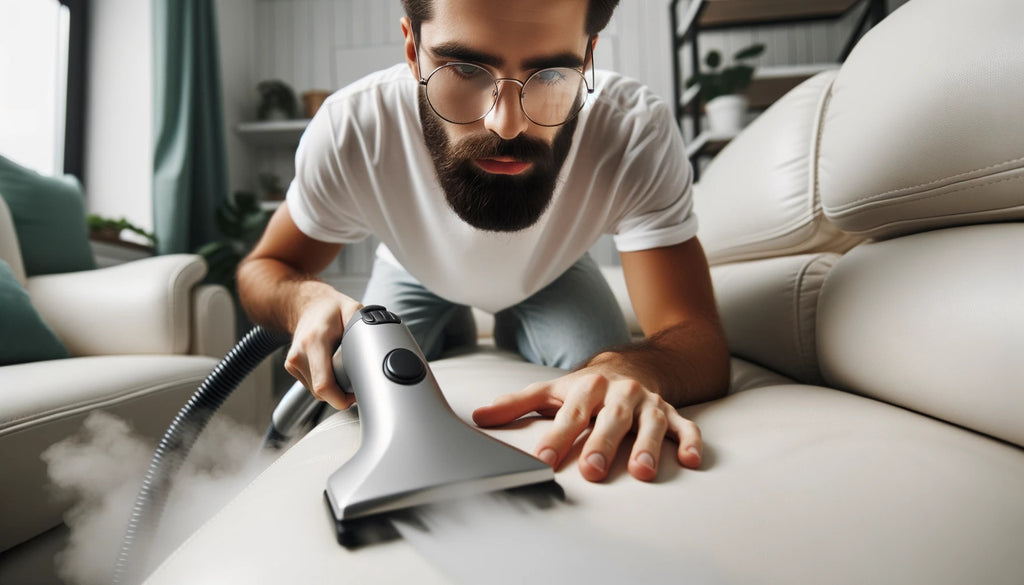
2. Using Commercial Leather Cleaners
While DIY solutions have their charm, sometimes you need the heavy-duty power of commercial cleaners, especially for those particularly stubborn stains.
a. Choosing the Right Product for White Leather
The market is flooded with leather cleaners, but not all are suitable for white leather. Here's what I look for:
- Formulated for White Leather: Some cleaners are specifically designed for white leather, ensuring they won't cause discoloration.
- No Harsh Chemicals: Avoid cleaners with bleach, ammonia, or other harsh chemicals. These can damage and discolor the leather.
- Check Reviews: Before purchasing, I always check reviews, especially from those who've used the product on white leather.
b. Application and Precautions
Using a commercial cleaner might seem straightforward, but there are some precautions to keep in mind:
- Patch Test: Before applying the cleaner to the entire surface, test it on a small, inconspicuous area. Wait for it to dry and check for any adverse reactions.
- Follow Instructions: Always read and follow the manufacturer's instructions. Some cleaners might need to be diluted, while others can be used directly.
- Use a Soft Cloth: Apply the cleaner using a soft, lint-free cloth. Work in circular motions for even coverage.
- Avoid Over-saturation: Less is more. Using too much product can leave a residue or cause damage.
In the end, whether you're opting for steam cleaning or using a commercial cleaner, the key is to approach the process with care and patience. White leather, while delicate, can be kept in pristine condition with the right techniques and a little bit of love.

V. Post-Cleaning Care
After the meticulous process of cleaning white leather, it's easy to think that the job is done. But, in my experience, post-cleaning care is just as crucial. It's like after having a sumptuous meal; you wouldn't just leave the table without cleaning up, would you? Similarly, after cleaning your white leather, there are essential steps to ensure its longevity and maintain its pristine appearance.
1. Conditioning White Leather
a. Why Conditioning is Essential
I remember the first time I held a piece of white leather; its softness, its smooth texture, and its luxurious feel were simply mesmerizing. But over time, without proper care, leather can lose these very qualities. It can become dry, brittle, and even start to crack. This is where conditioning comes into play.
Conditioning is to leather what moisturizing is to our skin. It replenishes the natural oils, keeps the leather supple, and ensures that it remains resistant to wear and tear. Especially with white leather, conditioning can prevent the material from looking dull and lifeless.
b. Best Leather Conditioners for White Leather
Now, not all leather conditioners are created equal. Some can darken the leather, while others might leave a greasy residue. For white leather, it's crucial to choose a conditioner that's both gentle and effective.
Over the years, I've tried numerous products, and a few have stood out. Water-based conditioners are typically a safe bet for white leather. Brands like Leather Honey, Bick 4, and Lexol offer conditioners that are not only effective but also ensure that the white leather remains true to its color.
When applying the conditioner, less is more. A small amount, applied evenly with a soft cloth, can work wonders. And always remember to test any product on an inconspicuous area first.
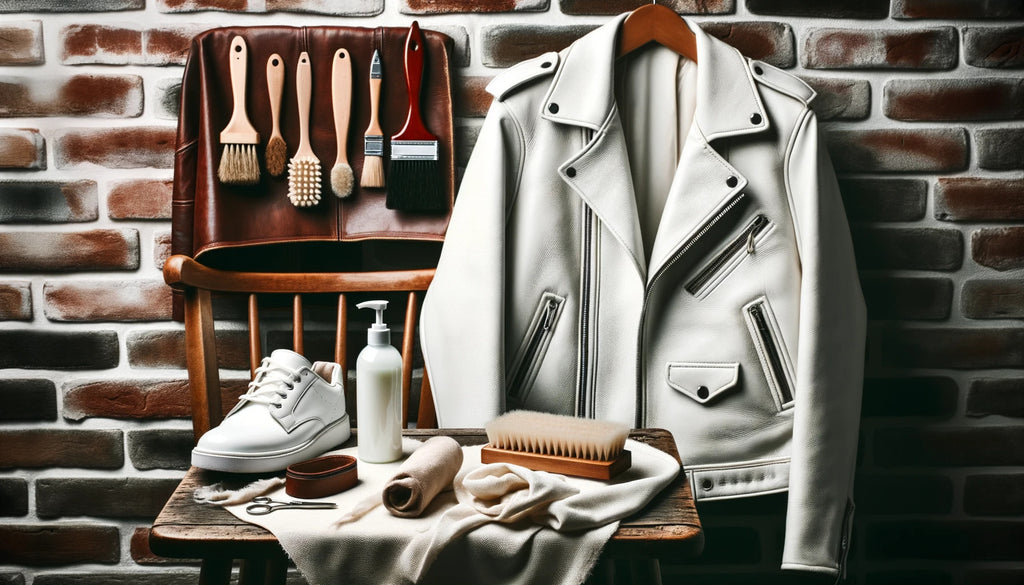
2. Protecting White Leather
a. Using Leather Protectants
Once your white leather is clean and conditioned, it's time to think about protection. Think of protectants as a shield, warding off stains, spills, and the harmful effects of UV rays.
For white leather, a good protectant can also prevent oxidation, the dreaded process that can turn your pristine white leather a shade of yellow. Products like Apple Brand Garde Rain & Stain Water Repellent and Cadillac Shield Spray are excellent choices. They form a protective barrier on the leather without affecting its texture or appearance.
b. Regular Maintenance Tips
Protection isn't just about using products; it's also about adopting certain practices. Here are some tips I've picked up over the years:
-
Storage: Always store white leather items away from direct sunlight. For items like bags or jackets, use dust bags or covers.
-
Immediate Action: Spilled something on your white leather? Act fast! The quicker you address a spill, the less likely it is to become a permanent stain.
-
Regular Dusting: Before any dirt has a chance to settle, give your white leather items a quick wipe with a microfiber cloth. This simple practice can make a world of difference.
-
Avoid Overloading: For white leather bags, avoid overloading them. Excess weight can strain the leather, leading to stretching or deformities.
White leather, with its elegance and charm, is truly a class apart. But it also demands a level of care and attention that's a notch above the rest. With the right practices, products, and a bit of love, your white leather items can remain as stunning as the day you bought them. And trust me, the effort is well worth the reward.

VI. Mistakes to Avoid
Navigating the world of white leather care can be a bit like walking through a minefield. One wrong step, and you could end up causing irreparable damage to your cherished items. Over the years, I've made my fair share of mistakes, and trust me, some of them were painful lessons. But the silver lining? I've learned from them, and today, I'm here to share these insights with you. Let's dive into some common pitfalls and how to steer clear of them.
1. Using Harsh Chemicals
a. The Dangers of Bleach and Ammonia
It's a tale as old as time. A stubborn stain on white leather, a desperate attempt to remove it, and the ill-fated decision to use bleach or ammonia. While these might seem like potent cleaning agents, they're a white leather's worst nightmare. Both bleach and ammonia are incredibly harsh chemicals. They can strip the leather of its natural oils, leading to dryness, cracking, and discoloration. And if you're thinking, "Well, it's white leather, so bleach should be fine," think again. Bleach can cause white leather to yellow, a far cry from the pristine white you were aiming for.
b. Safe Alternatives
So, what should you use instead? The answer lies in milder cleaning agents. Mild soaps, specially formulated leather cleaners, and even some natural solutions like diluted vinegar can be effective. The key is to always test any cleaning agent on an inconspicuous spot before applying it to a larger area. This way, you can ensure it doesn't adversely affect the leather.

2. Over-scrubbing the Surface
a. Potential Damages from Aggressive Cleaning
We've all been there. A stain that just won't budge, leading to increased frustration and the temptation to scrub harder. But here's the thing: leather, especially white leather, is delicate. Over-scrubbing can lead to scratches, cause the leather to thin out, or even remove its protective finish. And once that damage is done, it's often irreversible.
b. Gentle Cleaning Techniques
Patience is the name of the game when it comes to cleaning white leather. Instead of aggressive scrubbing, opt for gentle, circular motions. If a stain is particularly stubborn, it's better to apply a cleaning solution multiple times, allowing it to sit for a few minutes, rather than resorting to force. Soft microfiber cloths, sponges, and soft-bristled brushes can be your best allies in this endeavor.
While white leather requires a bit more TLC than its darker counterparts, with the right knowledge and techniques, it's entirely possible to keep it looking its best. Remember, it's not just about removing stains and dirt; it's about preserving the leather's integrity and ensuring it lasts for years to come. So, the next time you're faced with a white leather conundrum, take a deep breath, arm yourself with the right tools and knowledge, and tackle it with confidence.
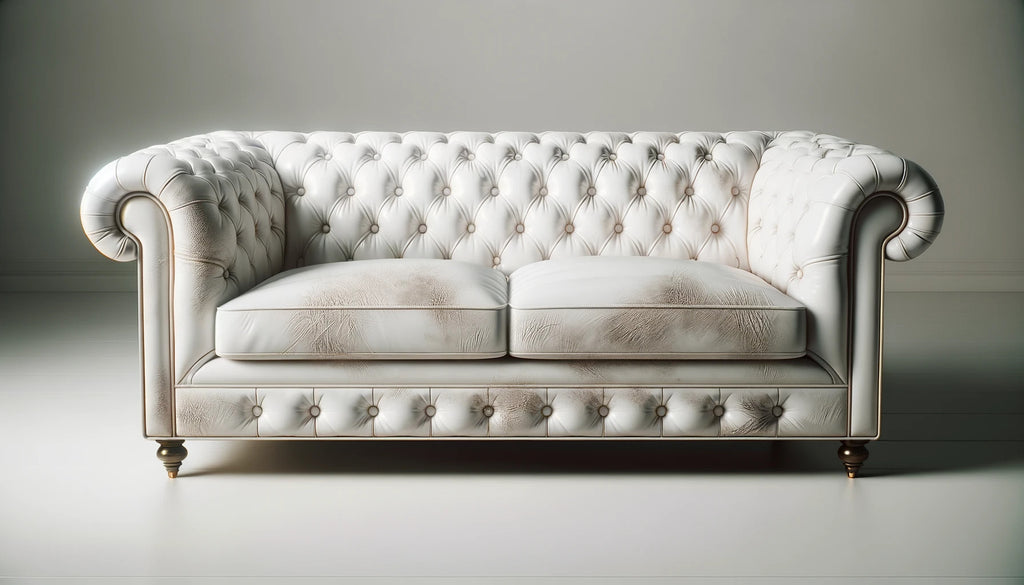
Conclusion
As we wrap up this comprehensive guide on white leather care, it's essential to revisit the core principles that underpin its maintenance. White leather, with its unmatched elegance and sophistication, demands a unique care regimen. It's not just about preserving its aesthetic appeal but ensuring its longevity and durability.
The importance of proper cleaning techniques cannot be overstated. As we've discussed, white leather is particularly susceptible to stains, discoloration, and damage. Using the right cleaning agents, being gentle during the cleaning process, and understanding the unique challenges posed by this material are all crucial. Remember, it's not just about removing stains but ensuring that the leather remains soft, supple, and free from damage.
Moreover, regular maintenance is the key to longevity. Just as we wouldn't wear the same outfit every day without washing it, we shouldn't neglect our white leather items. Regular cleaning, conditioning, and protection will ensure that your white leather pieces remain a cherished part of your collection for years to come.
Frequently Asked Questions
1. How often should I clean my white leather items?
- Answer: The frequency of cleaning white leather items largely depends on their usage. For items used daily, like shoes or handbags, a quick wipe-down every week with a deeper cleaning once a month is recommended. For less frequently used items, such as jackets or furniture, a monthly check with cleaning as needed should suffice.
2. Can I use baby wipes to clean white leather?
- Answer: Baby wipes might seem like a convenient option, but they often contain chemicals or fragrances that aren't suitable for leather. These chemicals can potentially damage or discolor the leather over time. It's always best to use products specifically designed for leather cleaning to ensure the material's longevity and appearance.
3. Is it safe to use vinegar on white leather?
- Answer: Vinegar, when diluted, can be an effective cleaning agent for certain stains on white leather. However, it's crucial to always conduct a patch test on an inconspicuous area first. If there's no adverse reaction, you can proceed, but always use it sparingly and ensure it's well-diluted.
4. How can I prevent my white leather sofa from yellowing?
- Answer: Yellowing of white leather can be a result of prolonged exposure to sunlight, air pollutants, or the use of incorrect cleaning products. To prevent this, it's essential to clean your sofa regularly, keep it away from direct sunlight, and use a high-quality leather protectant that offers UV protection.
5. What should I do if water spills on my white leather bag?
- Answer: If water spills on your white leather bag, it's essential to act quickly. Gently blot the water with a soft, absorbent cloth without rubbing. Let the bag air dry naturally in a well-ventilated area. It's crucial to avoid using direct heat sources like hairdryers, as they can damage the leather's natural oils and texture.
6. Can I use coconut oil to condition white leather?
- Answer: Coconut oil is a natural conditioner and can be used on some types of leather. However, it might darken white leather or leave a residue. If you're considering using coconut oil, always conduct a patch test on a hidden area first. If there's no discoloration, you can proceed with caution.
7. Why is my white leather cracking?
- Answer: Cracking in leather usually indicates dryness. Leather, being a natural material, requires moisture to maintain its flexibility. If it becomes too dry, it can start to crack. To prevent this, ensure you condition your white leather items regularly with a suitable leather conditioner to keep them hydrated and supple.
8. Is it safe to use magic erasers on white leather?
- Answer: Magic erasers, while effective for many cleaning tasks, can be quite abrasive. When used on white leather, they might cause scratches or remove the leather's finish. If you decide to use one, always test on a small, hidden area first and use very gentle motions.
9. How can I restore the shine on my white leather shoes?
- Answer: Over time, white leather shoes might lose their natural shine due to dirt and wear. After ensuring they are clean, you can restore their shine by applying a leather conditioner or cream. Buffing them gently with a soft cloth after application can also enhance their shine and luster.
10. Can I use hairspray to remove ink stains from white leather?
- Answer: Hairspray has been touted as a home remedy for ink stains on leather. While it can be effective in some cases, it might leave a sticky residue or cause discoloration. If you choose to use hairspray, apply it sparingly and clean the area with a mild leather cleaner afterward to remove any residue.
📫 Related Blog Posts:
📌 Leather Care Essentials: Best Oils and Maintenance Practices
📌 How to Stiffen Leather Like a Pro? From Supple to Sturdy
📌 Embossed vs. Engraved Leather: The Artistic Duel Unveiled
📌 Mastering the Art of Leather Lacing: A Comprehensive Guide
📌 What is Exotic Leather? From Wilderness to Wardrobe
📌 How to Style Leather Pants? A Guide From Rockstar to Runway
2 comments

















hi, I did not find the ratio of vinegar and water to clean dirt from the grooves of a white leather couch. you also mention a mild soap, but dont give suitable kinds. Dawn dish soap, what about laundry soap, maybe amway or norwex that has less fillers, or dishwasher liquid soap, leather is skin, what about ivory bar of soap on a toothbrush. maybe you can respond directly. my budget only allowed me to buy used sofa and love seat, and the seats look dry, worn, maybe cracked and have dirt in crevices. its the best I could afford, so want to love it and make it last. i use norwex cloths with water lots to clean, but its a lot of rubbing and slow go. also please recommend the best conditioner and protector for my situation. thanks.
Bonjour,
J’ai lu tous vos commentaires.
Cela m’a apporté beaucoup de réponses.
Par contre, pouvez-vous me dire quelle est la solution pour retirer les taches d’humidité car je vie aux Antilles
Merci de votre aide
Jean Baresse
Leave a comment